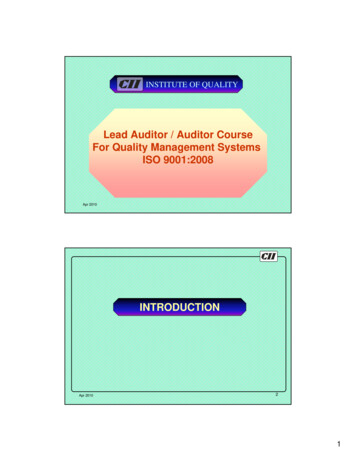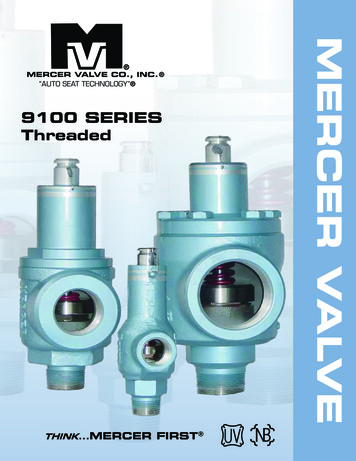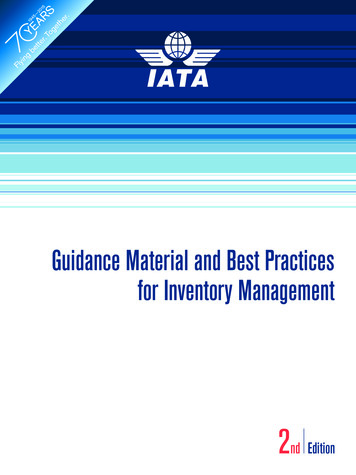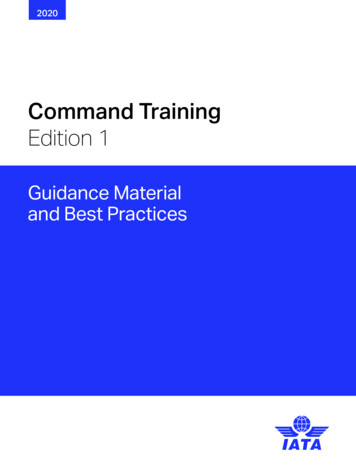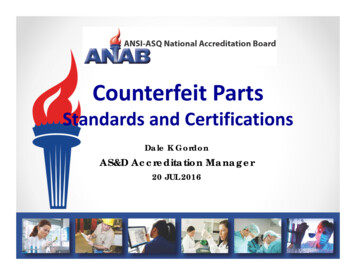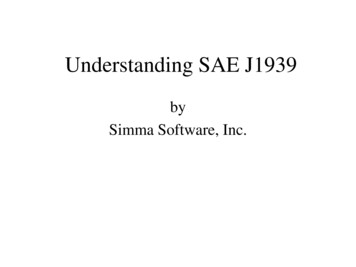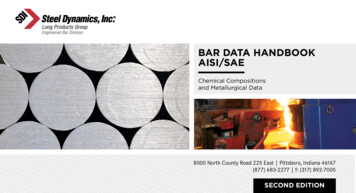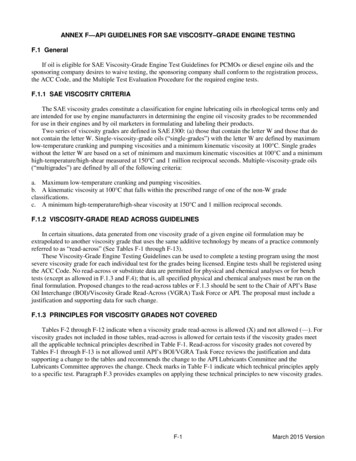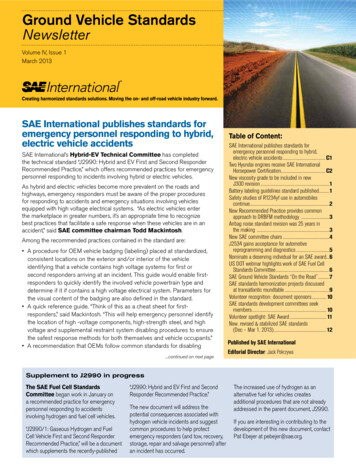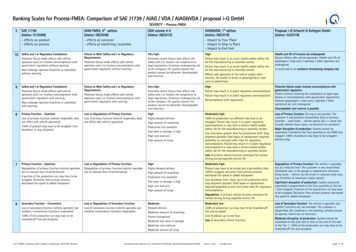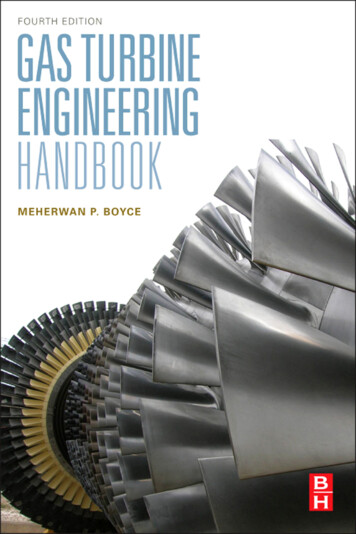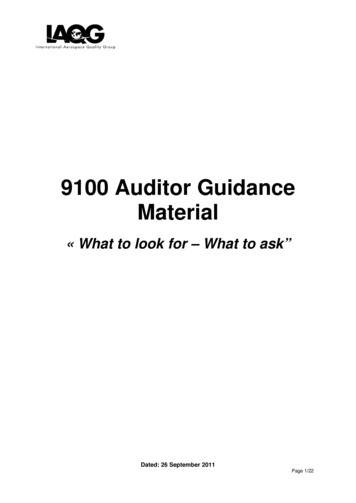
Transcription
9100 Auditor GuidanceMaterial« What to look for – What to ask”Dated: 26 September 2011Page 1/22
9100 Auditor Guidance MaterialIntroductionThis document provides general guidance and potential questions by auditteams when executing the audit process, described by the 9101:2010 standardfor 9100:2009 audits.Any issues identified during audits are to be documented against 9100:2009requirements. This guidance is not intended to add or take away from thestated standard requirements, but provide examples and thought stimulation onhow auditors can: identify applicable objective evidence (“What to look for”); and ask relevant questions (“What to ask”).Acceptable means of compliance are not limited to those items listed in thisdocument.NOTES:This ‘living’ document will be regularly updated and posted on the IAQGwebsite. This revision does not address 9110 and 9120 audits. This is also useful in preparation for an audit. Dated: 26 September 2011Page 2/22
Process Auditing ApproachWhen auditing each process identified by the organization, there are basic questions thatshould be asked, for example: Is the process identified and appropriately defined? Is the process identified and appropriately defined (inputs, outputs, resources &controls)? Are responsibilities of process owner and process performers assigned? Is the process implemented and maintained? Is the process effective in achieving the desired results?Other questions could include the following: What is the process? What is it trying to achieve?Who is the customer of the process?Does the process address applicable customer specific requirements?Are competencies identified?Is the process operating, as defined?What is the desired level of performance?Does it reflect specified customer targets / performance requirements?What are the measures (key performance indicators, etc.)?What is the current level of performance?Is the process performance regularly reviewed by Top management?Where performance is not being achieved, are improvement plans in place?NOTE:See also, the Guidance on the: “Concept and Use of the Process Approach formanagement systems” available on the ISO website, free of charge (ref : ISO/TC176/SC2/N544R3) and refer to 9101:2010 § 0.2.9101 Auditor Guidance Material – Dated: 26 September 2011Page 3/22
What to look for / What to askGeneral requirementsWhat to look forConsideration by the organization of: describing the activities of the organization in processes: input, output, constraints, resources and measure providing visibility, including sequence and interaction of QMS processes defined by the organization (e.g., process model, flowdiagram) formalizing continual improvement activities/efforts for defined processes compliance with customer and applicable statutory and regulatory requirements measuring main criteria:- How is this measured? (e.g., target setting, trends, on customer complaints, first pass yield, OTD reliability)- If out of target, how is this analyzed? How are actions taken?4.1Examples of objective evidence: process map list of customer and applicable statutory and regulatory requirements identification of process owners records on process effectiveness reviews, such as minutes of meetings measuring or evaluation methods of processes (how) criteria and methods used to ensure both operation & control are effective, e.g., objective of the process, quantitative targets suchas first pass yield, max rate non-conforming parts, lead-time, max flow-time, including maximum variation/spread availability of resources : man/machine capacity plans (short term and M/LT) information needed for each process, e.g., specifications (design), orders, drawings(production), work-orders, job-cards, Monitoring(linked with am objectives/targets) data on improving its effectiveness, e.g., statistics on product deficiency rates documents, including records, related with outsourced processes, e.g., contracts, conformity statements)NOTE:The use of “Turtle diagram” or SIPOC approach is a means of compliance : description of input, output, process, resources, method,measurementsDocumentation requirements4.2.1GeneralWhat to look for4.2Consideration by the organization of: availability of relevant Quality Management System documentation and changes (not only procedures) at all places to be asked allthrough the audit existence of a list of documents, including the documented procedures required by the QMS standard and by the organization itself availability of documents in the different work places / shop floors by asking various people issue of the documents and regular updates samples upwards and downwards showing that the references to and from the procedures are correct (if the documentedprocedures are not part of the QM)NOTES:The list itself is NOT a requirementThe international standard requires, at least, the following documented procedures:- 4.2.3 Control of documents- 4.2.4 Control of records- 8.2.2 Internal audits- 8.3Control of nonconforming product- 8.5.2 Corrective actions- 8.5.3 Preventive actionsDocumentation requirements4.2.2Quality manualWhat to look for4.2Examples of objective evidence: scope of the QMS with respect to the scope of certification (coverage) justifiable exclusions (only to clause 7, ensure that exclusions are mentioned in the scope of certification) and their justification Quality manual and procedure references, issueWhat to askRecommended questions : Are the processes of the QMS explicitly mentioned and descried in the QM? Are the process interactions described? In what manner?9101 Auditor Guidance Material – Dated: 26 September 2011Page 4/22
What to look for / What to askDocumentation requirements4.2.3Control of documentsWhat to look forConsideration by the organization of: who is responsible for development, approval, distribution, issue control (date, number, .) - update procedures, instructions, definition / manufacturing / maintenance files, templates, purchasing contracts, change notes, . use of electronic tools for documents validation by workflow4.2Examples of objective evidence: the documentation approval status and update status/issue control if not valid documents (paper or electronic) can be in use during product realization (sampling)What to askRecommended questions : How are documents of external origin controlled? (Take some samples and verify the currency, e.g., customercontracts/specifications, supplier certificates of conformity, ) Are there retention requirements? If yes, how are they retained? (Take some samples on retrieval, based on the retentionrequirements)4.2.4Control of recordsWhat to look for4.2Consideration by the organization of: how record formats are identified and controlled, including record ID’s retention times and conditions including the storage area who is responsible for storage of records are records legible filing of records destructionWhat to askRecommended questions : Ask for electronic versus paper records How long are records kept regarding the statutory, regulatory and customer’s requirements? Is the method for controlling records of supplier’s part of the documented procedure? How are records communicated to the supplier, e.g., in supplier contracts? Existence of samples on retrieval, based on the retention requirements?9101 Auditor Guidance Material – Dated: 26 September 2011Page 5/22
What to look for / What to askManagement commitmentWhat to look forConsideration by the organization of: written management statement, e.g., in the quality manual or separate the way(s) it is communicated, e.g., in the QM, posters, newsletters, etc. attendance to top management reviews improvement plans involvement of management in Management reviews is management involved on a regular basis?5.1Typical examples of evidence of commitment: top management meetings, activities, , regarding Quality policies and objectives are effective and understood throughout the organization policies and objectives are appropriate for continual improvement of the Quality Management System and for the achievement ofcustomer satisfactionWhat to askTop management interview {including Business Unit manager(s)} – Recommended questions: names and positions of top managers? is top management aware of and committed to Quality? do employees understand the quality policy and how they contribute to objectives? are quality objectives measurable (see 5.4.1)? are top managers involved in management reviews? does top management answer the most important questions linked with his commitment and involvement or does he delegate thisto his Quality manager?NOTE:See also 9101 section 4.1.2.2. Organizational Leadership ApproachCustomer focusWhat to look for5.2Examples of objective evidence: Customer identification On-Quality Delivery (OQD) and On-Time Delivery (OTD) performance dashboard Communication arrangements Method of engagement Joint improvement efforts Campaigns Satisfaction surveysWhat to askTop management interview – Recommended questions: Who are the key customers? What is the level of focus relating to product conformity and on time delivery? How are they measured? With which periodicity? What are the targets/objectives to compare with? (If out of target, give examplesof actions taken) Are the methods of measuring also discussed with the major customers, or are there any customer requirements on this?Quality policyWhat to look for5.3Consideration by the organization of: Management having effectively “translated” the quality policy into understandable words and guidelines at all levels of theorganization, with corresponding objectives at each applicable function / level Personnel having the required awareness, understanding and knowledge of the way the organization’s quality policy relates to theirown activity, regardless of the terms used by such people to express their understanding?Examples of objective evidence: availability and relevance and link of policy and objectives method of communication top / down effective dissemination of the quality policy by appropriate communication periodic review of suitability, e.g., during management review9101 Auditor Guidance Material – Dated: 26 September 2011Page 6/22
What to look for / What to askPlanningWhat to look for5.4Examples of objective evidence: objectives are : Specific, Measurable, Attainable, Realistic and Time-bound (SMART) at all levels of the organization (they shouldbe documented) Quality objectives are suitably cascaded throughout the organization’s structure and processes linking the top level quality policy and specific operational objectives overall performance of the organization reflects the aims of the quality policy and reasonably meets the quality objectives objectives assigned by management are consistent with Aerospace and/or customer requirements (example: On Time Delivery 95%, Quality default rate 1%)Responsibility, authority and communicationWhat to look for5.5Employee awareness of responsibilities and authorities - Examples of objective evidence: Organization chart and responsibilities description procedure or job description (or other standardized document) where the responsibilities are described, including 5.5.2requirements communication process effectiveness Top management, employees at all levels in the organization, contractors, generate, receive and respond to communications the information to be communicated is clearly defined, appropriate and accurate to the purpose of the communication the means used for communication is appropriate to the literacy and other skills of those expected to receive and act upon theinformation provided monitoring takes place to ensure that the information communicated is acted upon and the desired outcome achieved the records necessary to demonstrate that communication has occurred, is effective and subject to continual improvement and arereadily available promotion of customer requirements awareness occurrences of management representative reporting to top management, organizational freedom (prevent delivery of nonconforming parts, stop non-conforming processes, etc.)Management reviewWhat to look forConsideration by the organization that: management review input /output are:- consistent with organization identified processes- relevant to the organization’s size and complexity and that they are used to improve the business the management review process includes elements of Quality Management System planning where changes to processes andsystems are being considered5.6Examples of objective evidence: availability of input / output data such as: statistical data, graphics, summary tables, reports on product and delivery performanceand results of internal and external audits, . minutes of meeting action(s) plan(s) issued from management review how the organization’s management is structured and how the management review process is used within this structure Evidence that the following points have been considered during the review:- impact of changes to the management system or business as a whole, on other parts of the system or business- proposed changes are evaluated before implementation- the controls needed are identified before the outsourcing of a process starts how output from top management review are flown-down into organization at operational level output from the management review: decisions to modify procedures, methods, training of personnel, hiring additional staff,additional process controls/inspections9101 Auditor Guidance Material – Dated: 26 September 2011Page 7/22
What to look for / What to askProvision of resourcesWhat to look for6.1Consideration by the organization that: the adequacy and effective management of the resources to achieve planned results, irrespective of the way the organization isstructured and identifies its processes past and present performance (e.g., us
This document provides general guidance and potential questions by audit teams when executing the audit process, described by the 9101:2010 standard for 9100:2009 audits. Any issues identified during audits are to be documented against 9100:2009 requirements. T his guidance is not intended to add or take away from the stated standard requirements, but provide examples and thought stimulation .File Size: 216KBPage Count: 22
